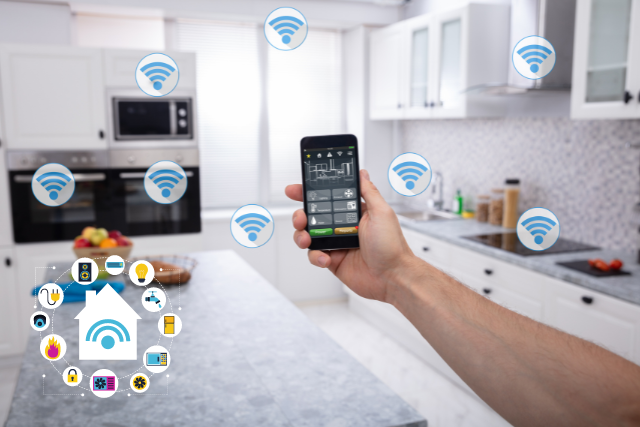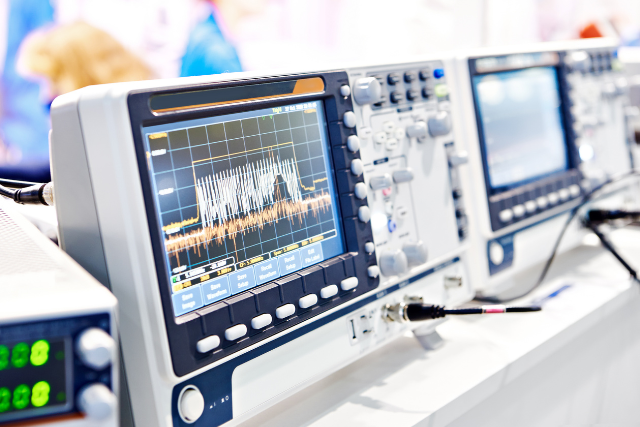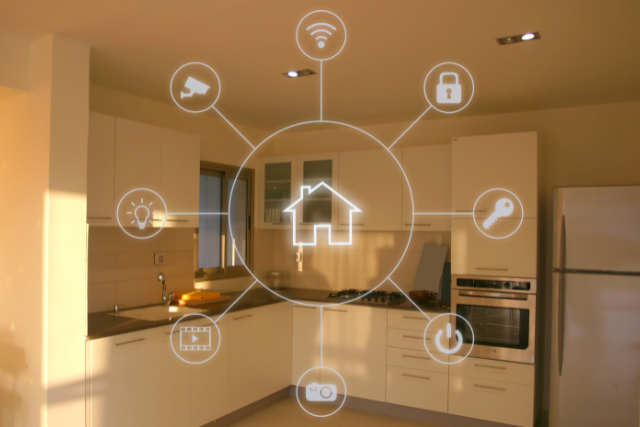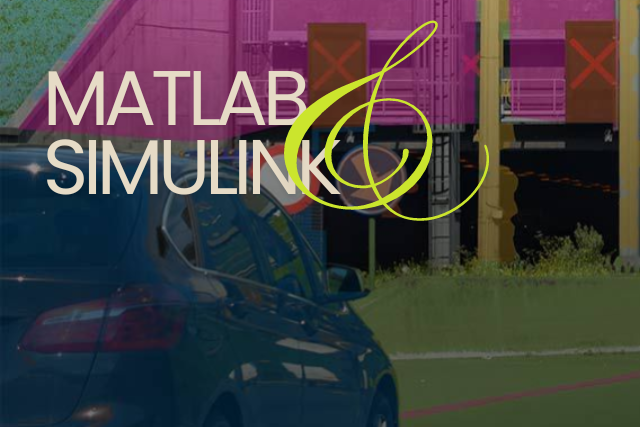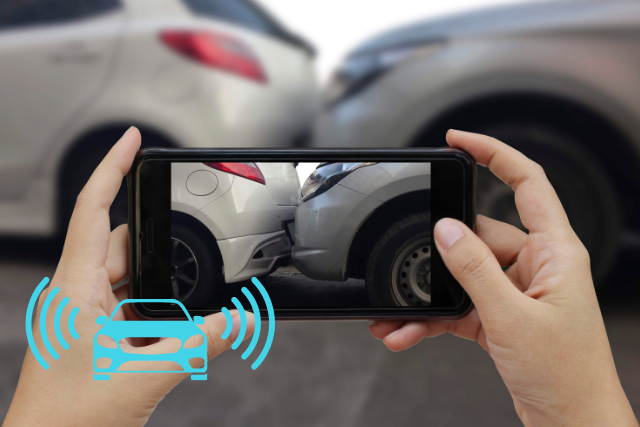The integration of smart devices in homes is becoming more seamless and sophisticated, offering unprecedented levels of control, security, and efficiency.
In this blog post, we will explore the latest smart home technology trends shaping the future of residential living, making homes more innovative, safer, and energy-efficient.
Key Trends in Smart Home Technology
- Voice-Activated Systems
- Artificial Intelligence and Machine Learning Integration
- Home Automation and Control
- Energy Efficiency and Sustainability
- Enhanced Home Security
- Smart Kitchens and Appliances
- Health and Wellness Monitoring
- Interoperability and Ecosystem Integration
Voice-Activated Systems
Voice-activated systems have become a cornerstone of modern smart homes. Devices like Amazon Alexa, Google Assistant, and Apple’s Siri are leading the charge in making homes more interactive and user-friendly. These systems allow homeowners to control various aspects of their home environment, from adjusting thermostats to playing music, using simple voice commands.
The future of voice-activated systems lies in their growing ability to understand context and intent, which enhances user experience. Natural language processing (NLP) advances make these systems more intuitive, capable of handling complex commands and providing more accurate responses.
We can expect even greater integration with home systems, allowing for more comprehensive automation and control.
Artificial Intelligence and Machine Learning Integration
Integrating Artificial Intelligence (AI) and Machine Learning (ML) in smart home technology is another trend gaining momentum. AI-driven systems learn from user behaviour, preferences, and routines to provide personalized experiences.
Smart thermostats use ML to optimize heating and cooling based on past user settings and external weather conditions, thereby enhancing comfort and energy efficiency.
AI and ML are also crucial in improving home security systems. These technologies enable intelligent cameras to distinguish between regular activity and potential security threats, sending alerts only when necessary.
Home Automation and Control
Home automation continues to expand beyond essential lighting and climate control. Today’s systems integrate various devices and systems into a cohesive network that can be controlled remotely via smartphones or centralized control hubs. This includes everything from smart locks and surveillance cameras to irrigation and home entertainment systems.
The trend towards smart home ecosystems is growing, where multiple devices communicate and work together. This integration facilitates complex automation, such as setting a home security system to activate when you leave the house and deactivate when you return, all based on your smartphone’s location data.
Energy Efficiency and Sustainability
Energy efficiency and sustainability are critical considerations in designing and implementing smart home technologies. Smart thermostats, lighting systems, and appliances are designed to reduce energy consumption by adapting to the user’s lifestyle and preferences.
Smart thermostats like Nest and Ecobee can adjust heating and cooling based on occupancy and weather forecasts, significantly reducing energy waste.
Solar panels and intelligent energy management systems are also becoming more popular. These systems optimize energy use, reduce reliance on non-renewable sources, and provide detailed insights into energy consumption patterns.
Enhanced Home Security
Home security has always been a priority, but the rise of smart technology has taken it to new heights. Modern smart security systems offer features like high-definition video surveillance, facial recognition, motion detection, and remote monitoring. These systems can alert homeowners of suspicious activities in real time, allowing prompt action.
Biometric technologies, such as fingerprint and facial recognition, are being integrated into smart locks, providing an additional layer of security. Moreover, these systems are becoming more user-friendly, allowing homeowners to manage their security settings and monitor their properties from anywhere in the world via smartphone apps.
Smart Kitchens and Appliances
The kitchen is a focal point for smart home innovation, with a growing array of smart appliances designed to simplify cooking and meal planning.
Smart refrigerators can keep track of food inventory, suggest recipes based on available ingredients, and even place grocery orders. Ovens, cooktops, and microwaves are becoming smarter, offering pre-programmed cooking modes, voice control, and remote operation.
These smart appliances are often integrated into a broader smart home ecosystem, allowing for synchronized operation. For instance, a smart oven could preheat automatically when a recipe is selected on a connected smart device.
The convenience and efficiency offered by these smart kitchen technologies make them an attractive addition to any modern home.
Health and Wellness Monitoring
Health and wellness have become central themes in developing smart home technologies. Devices like smart beds, air purifiers, and lighting systems are designed to promote better sleep, improve air quality, and support overall well-being. Smart mirrors and scales can monitor fitness metrics and provide personalized health insights.
The rise of wearable technology also integrates with smart home systems, offering seamless health monitoring and data sharing. For instance, a smart home system can adjust the lighting and temperature based on the user’s sleep patterns recorded by a wearable device.
This trend towards integrated health and wellness solutions is expected to continue, with a growing focus on creating home environments that support physical and mental well-being.
Interoperability and Ecosystem Integration
As the number of smart devices in homes increases, the importance of interoperability and ecosystem integration becomes more apparent.
The challenge lies in ensuring that different devices, often from various manufacturers, can communicate and work together seamlessly. Open standards and protocols, such as Zigbee, Z-Wave, and Matter facilitate this interoperability.
Consumers increasingly prefer integrated ecosystems where all devices are controlled through a single interface, whether a smartphone app or a centralized home hub. This trend drives the development of more cohesive smart home solutions, ensuring a smoother and more intuitive user experience.
Conclusion
The landscape of smart home technology is rapidly evolving, driven by AI, automation, and connectivity advances. As these technologies become more sophisticated and accessible, they reshape our living environments, making homes more efficient, secure, and responsive to our needs.
The trends highlighted in this blog post offer a glimpse into the future of smart living, where technology seamlessly integrates into our daily lives, enhancing comfort, convenience, and sustainability.
Embracing these smart home technologies can transform your living space into a more efficient, secure, and enjoyable environment. Whether you’re interested in automating everyday tasks, enhancing your home’s security, or reducing your energy footprint, there’s an intelligent solution available to meet your needs.
FAQs
1. What are the benefits of smart home technology?
Smart home technology enhances convenience, security, and energy efficiency. It allows for automation of routine tasks, provides remote access and control, and can significantly reduce energy consumption.
2. How does AI improve smart home systems?
AI improves smart home systems by learning from user behavior to provide personalized experiences, optimizing energy use, and enhancing security through advanced threat detection capabilities.
3. Are smart homes secure?
Yes, smart homes can be very secure, especially with advanced security features like biometric authentication, real-time alerts, and remote monitoring. However, it’s important to ensure proper setup and maintenance to protect against potential vulnerabilities.
4. How does smart home technology contribute to sustainability?
Smart home technology contributes to sustainability by optimizing energy use, reducing waste, and supporting renewable energy sources. Devices like smart thermostats and lighting systems adjust based on occupancy and environmental conditions, minimizing unnecessary energy consumption.
5. What is the importance of interoperability in smart home systems?
Interoperability ensures that different smart devices can communicate and work together seamlessly, providing a cohesive and efficient smart home experience. It allows users to control multiple devices through a single interface, enhancing usability and convenience.
6. Can smart home technology improve health and wellness?
Yes, smart home technology can improve health and wellness by monitoring environmental factors like air quality, promoting better sleep, and integrating with wearable devices to track health metrics. These systems can provide insights and adjustments that support overall well-being.

